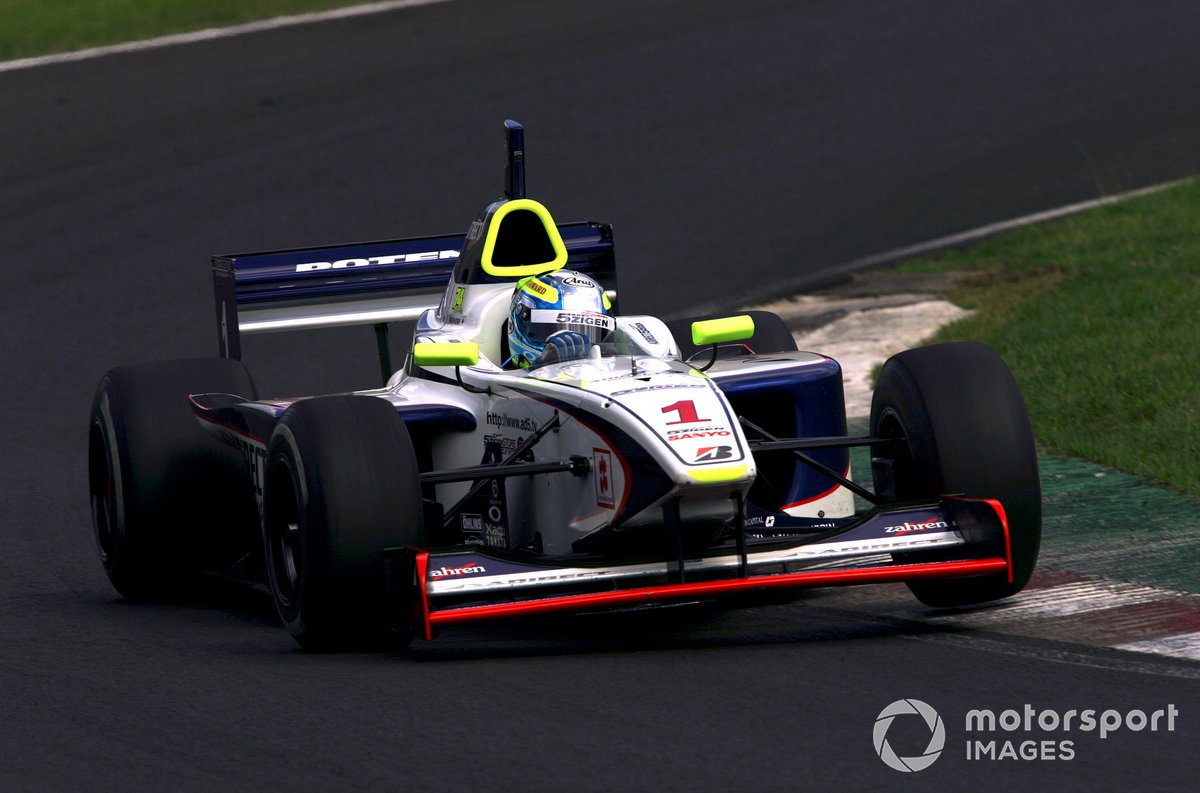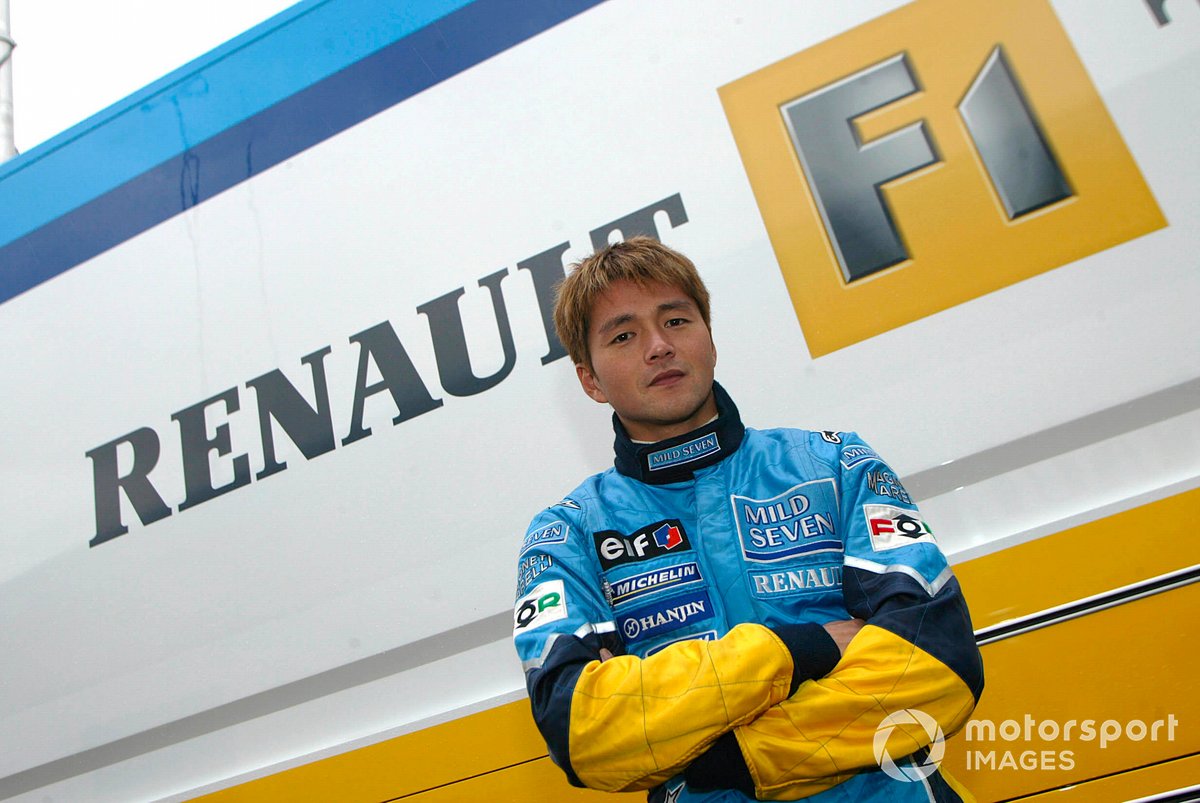
Back in 2013, Autosport compiled a list of the 50 greatest drivers never to have raced in F1. Just one Japanese driver made the grade, and that was Satoshi Motoyama, who at No. 27 ranked ahead of some illustrious names, including the late Gonzalo Rodriguez, 1999 Indianapolis 500 winner Kenny Brack, multiple GT champion Christophe Bouchut and Le Mans ace Andre Lotterer (prior to his one-off F1 outing at Spa in 2014).
Motoyama is best known for his feats in his native Japan, becoming champion in what was then known as Formula Nippon four times - a modern-era record - and racking up another three titles in JGTC/SUPER GT in a career that earned him the nickname ‘The Emperor’.
But a little under 20 years ago, Motoyama made two outings at the wheel of F1 machinery as he made a serious bid to break into the rarified world of grand prix racing. Unfortunately those efforts came to nothing, leaving Motoyama’s unfulfilled ambitions as one of the big ‘what-if’ stories for Japanese motorsport fans to ponder.
By the time Motoyama first managed to land a test outing in F1, he was already 32 years old. His only professional experience of driving outside of Japan comprised two appearances in the Le Mans 24 Hours for long-time employer Nissan, firstly with the R390 GT1 in 1998 and then with the short-lived R391 prototype the following season.
That was because he was focused purely on building his reputation in Japan, which he succeeded in doing with Formula Nippon titles in 1998 and 2001. But at the start of the season that would yield his third crown in 2003, the passing of his childhood friend Daijiro Kato in a crash in that year’s MotoGP race at Suzuka prompted a change of approach.
“From the first time I won the Formula Nippon title, I had some contact with F1 teams, but honestly I had no real intention of racing overseas,” recalls Motoyama. “But after my good friend Daijiro Kato died, I wanted to carry on his legacy and show him how hard I was working, and I decided it was time to challenge myself overseas.
“In 2003 I was able to win the title in both Formula Nippon and JGTC. I felt there was no higher challenge in Japanese racing and that if the chance came up I would go to F1.

“At that time, it just so happened that Jordan was looking for a driver to use in Friday practice, so I thought let’s go and try it. I wouldn’t know how an F1 car felt to drive unless I tried it, and the timing was good, so I went and grabbed the chance.”
Jordan was among the teams to agree to give up a certain amount of private testing in 2003 in exchange for being able to run a third car on Fridays during grand prix weekends. This is what opened the door for Motoyama to drive at that year’s Japanese Grand Prix at Suzuka, offering a suitably low-pressure way for him to sample an F1 car around a familiar track.
Motoyama’s best effort during the two-hour session was a 1m35.044s, a little over a second-and-a-half behind Jordan number one Giancarlo Fisichella and just under a second slower than his old Formula Nippon rival Ralph Firman in the second Ford-powered EJ13.
There was a gap of something like 300 horsepower compared to Formula Nippon cars of the time. Driving around Suzuka, I was like, 'Jeez, this is narrow!'
Satoshi Motoyama
By 2003 Jordan was firmly established as the second-slowest team behind Minardi, but Motoyama was still blown away by the performance gulf compared to the one-make Lola-Mugen Honda package that would take him to that year’s Formula Nippon title.
“In those days F1 cars were very high-tech,” says Motoyama. “They had semi-automatic gearboxes which almost felt automatic. But the thing that surprised me the most when I first drove it was the power. There was a gap of something like 300 horsepower compared to Formula Nippon cars of the time. Driving around Suzuka, I was like, ‘Jeez, this is narrow!’”
A week after the Japanese GP, Motoyama duly wrapped up his third Formula Nippon crown with a race to spare at Motegi, and the following month he and NISMO co-driver Michael Krumm delivered Nissan the title in JGTC, the forerunner to SUPER GT. It was the latter achievement that opened the door for a second bite of the F1 testing cherry.
Back in 2003, the Renault-Nissan alliance was still a relatively novel thing, and this connection led to Motoyama being handed a day at the wheel of the Renault R23B for a day at Jerez in early December after both of his main campaigns in Japan had concluded.
This would prove a much sterner test than Motoyama’s Jordan outing at Suzuka. This time he would be thrown in the deep end at a totally unfamiliar track, shared with 15 other drivers, and at the wheel of a much more competitive car. Just to top things off, he had none other than Fernando Alonso as his benchmark in the sister Renault.
Motoyama admits the prospect made him “nervous”, but he knuckled down to complete 49 laps over the course of the day, the fastest of which was a 1m19.992s. That put him 12th and around 2.1s off the pace of future champion Alonso, but Motoyama reckons that when he and Alonso were both on the same tyres, he was within a second of the Spaniard.

Of his day in the R23B, Motoyama recalls: “Renault finished high up in that year’s championship [fourth], so compared to the Jordan, it was more refined, felt more high-quality, and was an extremely easy car to drive. I don’t really know what they [the Renault hierarchy] thought of my performance. But I didn’t think it was especially difficult to drive.
“I understood from the outset that testing for Renault did not mean I was going to get a seat with Renault. But I thought in any case that nothing would happen if I didn’t get involved in things, and that if I tried various things something good could come out of it.”
Needless to say, with Alonso and Jarno Trulli already signed up for 2004, there was no way for Motoyama to stake his claim to a race drive. And even landing a seat at a minnow team like Jordan or Minardi was always going to prove an uphill struggle without the financial backing that those teams needed to stay afloat during this manufacturer-dominated era.
“It was a really great experience to be able to drive the latest F1 cars at that time, but in terms of actually entering the F1 world and being an F1 driver, it’s a totally different story,” Motoyama continues. “I thought it would be impossible to do my job in F1 properly without a proper management structure behind me, and I didn’t have that.
“Even so, during that winter I searched for every possibility I could. There were a lot of problems involving money, so it was a stressful and tough winter. On top of that, at the same time I lost my seat in Japan [with Team Impul in Formula Nippon].”
Focusing on F1 meant Motoyama found his Formula Nippon seat at Impul taken by future Super Aguri driver Yuji Ide. That left the three-time champion having to reunite with the underdog 5Zigen team (pronounced Go-zigen), which served as a fresh motivation.
“For several years 5Zigen had been struggling” Motoyama says, "but when I was unable to race in [All-Japan] F3 I was approached by [5Zigen boss Shoji] Kinoshita and I was able to rejoin F3 and from there make a career as a racing driver. So in part to express my gratitude, I joined 5Zigen. Winning with 5Zigen became my new challenge.

“Up to that point I was driving for Impul, and in that sense, while I wouldn’t say I was able to win easily, I did think that personally it would be interesting to have a new challenge.”
Motoyama managed to win a race for 5Zigen but a title shot proved beyond his reach, although he and new team-mate Richard Lyons (who incidentally was that year’s Formula Nippon champion) were able to successfully defend Nissan’s JGTC crown.
In 2005 he returned to Impul in a third car and won his fourth Formula Nippon title, and in 2008 he and Benoit Treluyer grabbed SUPER GT honours for Nissan, cementing Motoyama’s reputation as the finest domestic driver of his generation. He would remain part of Nissan’s GT500 line-up until the end of the 2018 season, only standing down at the age of 47.
I knew that I wasn’t the type of driver who was aiming for F1. I liked the convenience and freedom of living in Japan
Satoshi Motoyama
Realistically, testing or no testing, Motoyama was never likely to end up in F1. For all his obvious talent, he had no connections in Europe, and as a Nissan driver he also lacked the opportunities that could have arisen from being associated with Honda or Toyota. His age also counted against him; years of struggling to get established in All-Japan F3 meant he was already in his late 20s by the time of his maiden Formula Nippon title in 1998.
But Motoyama still looks back with pleasure on his two chances to sample grand prix machinery, having proved to himself he could hack it in the world’s fastest single-seaters at a point in his career that he felt he had done everything there was to do in his homeland.
“F1 was not my dream,” he says. “To be honest, [before 2003] I hadn’t given the idea of becoming an F1 driver much serious thought.
“There are many different ways for racing drivers to challenge themselves, and it’s not like everybody has to aim for F1. I knew that I wasn’t the type of driver who was aiming for F1. I liked the convenience and freedom of living in Japan.
“However, I did want to drive an F1 car and I wanted to confirm I had the skills to do so. I thought to myself, ‘Yep, I can handle it’. So it was a good experience.”








